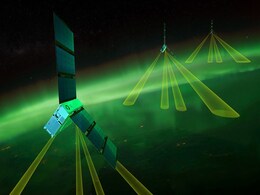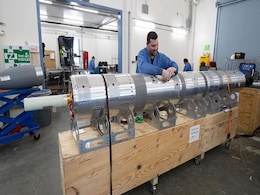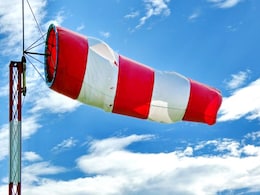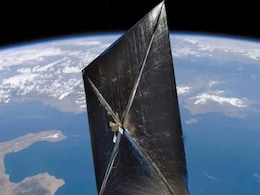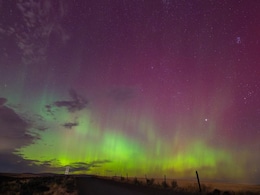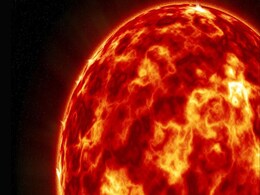Weather Satellite
- All
- News
- Videos
-

NASA's New Satellite Duo Begins Tracking Mysterious Auroral Electrojets
- Thursday May 1, 2025
- Written by Gadgets 360 Staff
The EZIE mission is shaping up to be a breakthrough in space weather research. Launched in March 2025, its three satellites are now orbiting Earth and collecting data on auroral electrojets, massive energy currents near the poles. Scientists believe the results could lead to better forecasting tools and stronger, safer satellite systems.
-
 www.gadgets360.com
www.gadgets360.com
-

Hidden Solar Cycle Could Reshape Space Weather for the Next 50 Years, Finds Study
- Saturday April 19, 2025
- Written by Gadgets 360 Staff
A hidden solar cycle is emerging, potentially intensifying space weather events over the next 50 years. While this cycle may raise concerns about geomagnetic storms and satellite disruptions, scientists believe it could also offer valuable opportunities to advance space weather forecasting, study Earth's magnetic field, and improve our resilience t...
-
 www.gadgets360.com
www.gadgets360.com
-

Amazon's Project Kuiper Satellites Launch Scrubbed Due To Poor Weather
- Thursday April 10, 2025
- World News | Agence France-Presse
Like Starlink, the Kuiper service is designed to provide internet access to even the most remote and underserved areas around the world, including war zones or disaster-struck areas.
-
 www.ndtv.com
www.ndtv.com
-

NASA to Launch Three Rockets in Alaska to Study Auroral Substorms’ Impact
- Saturday March 29, 2025
- Written by Gadgets 360 Staff
NASA is conducting a rocket experiment from Poker Flat Research Range in Alaska. Three rockets will launch within a three-hour window to study how auroral substorms influence the Earth's upper atmosphere. Scientists will observe whether auroras drive vertical convection or if acoustic-buoyancy waves spread their energy over a wider region. Vapour t...
-
 www.gadgets360.com
www.gadgets360.com
-

Partial Solar Eclipse of March 2025: Satellite Images to Show Moon’s Shadow
- Saturday March 29, 2025
- Written by Gadgets 360 Staff
A partial solar eclipse will take place on March 29, 2025, visible across parts of Europe, Africa, and North America. The event will reach its peak in Nunavik, Canada, where 94% of the sun will be covered at sunrise. From space, weather satellites like GOES-16 and Himawari will capture images of the moon’s shadow. The International Space Station ...
-
 www.gadgets360.com
www.gadgets360.com
-

Aardvark Weather AI-Powered Weather Forecasting System Unveiled, Does Not Require Supercomputers
- Friday March 21, 2025
- Written by Akash Dutta, Edited by Siddharth Suvarna
Aardvark Weather, an artificial intelligence (AI) system for weather forecasting that offers several advantages over traditional methods, was unveiled on Thursday. The fully AI-driven system is said to be capable enough to replace the existing systems that require custom supercomputers and a team of experts to deliver predictions. It is also said t...
-
 www.gadgets360.com
www.gadgets360.com
-

NASA’s EZIE Satellites Begin Mission to Study Auroral Electrojets and Space Weather
- Friday March 21, 2025
- Written by Gadgets 360 Staff
NASA’s Electrojet Zeeman Imaging Explorer (EZIE) mission has been launched aboard a SpaceX Falcon 9 from Vandenberg Space Force Base. The trio of small satellites will map auroral electrojets, powerful currents in Earth’s atmosphere linked to solar storms. Their data will enhance space weather prediction models and help understand planetary mag...
-
 www.gadgets360.com
www.gadgets360.com
-

NASA's MMS Mission Marks 10 Years of Magnetic Reconnection Discoveries
- Monday March 17, 2025
- Written by Gadgets 360 Staff
NASA's Magnetospheric Multiscale (MMS) mission has completed a decade of discoveries, advancing the study of magnetic reconnection—a crucial process in space physics. The four-satellite fleet has enabled over 1,500 research papers, refining theories and revealing unexpected reconnection locations. The mission has also set records for GPS tracking...
-
 www.gadgets360.com
www.gadgets360.com
-

Solar Sail Satellites Could Enhance Space Weather Forecasting and Alerts
- Tuesday February 18, 2025
- Written by Gadgets 360 Staff
Solar sail satellites, harnessing sunlight for propulsion, are being developed to improve space weather forecasting. NOAA and NASA’s Solar Cruiser project aims to extend geomagnetic storm alert times by 50%, reducing risks to power grids, GPS, and air traffic. The new spacecraft, expected to launch in 2029, will move beyond traditional observatio...
-
 www.gadgets360.com
www.gadgets360.com
-

Tiny Plasma Jets on Sun Identified as Key Drivers of Solar Wind
- Friday February 14, 2025
- Written by Gadgets 360 Staff
Observations from ESA’s Solar Orbiter have revealed that tiny plasma jets, known as picoflares, are responsible for both the fast and slow components of the solar wind. The discovery challenges previous assumptions that different mechanisms drive these solar wind types. With further research, scientists hope to refine space weather predictions, p...
-
 www.gadgets360.com
www.gadgets360.com
-

May 2024 Solar Storm Triggers Unusual Radiation Belts, Raising Space Safety Concerns
- Wednesday February 12, 2025
- Written by Gadgets 360 Staff
A significant solar storm in May 2024 led to the creation of two temporary radiation belts, detected by the CIRBE satellite in June. One belt contained high-energy electrons, while the other was rich in protons, a rare occurrence. While the electron belt dissipated in three months, the proton-dominated belt remains, potentially affecting space miss...
-
 www.gadgets360.com
www.gadgets360.com
-

NASA’s PUNCH Mission Set to Track the Sun’s Corona and Solar Wind in 3D
- Friday February 7, 2025
- Written by Gadgets 360 Staff
NASA’s PUNCH mission, set for launch on Feb 27, will deploy four satellites to study the transition between the sun’s corona and the solar wind. The mission aims to improve understanding of space weather by capturing 3D images, helping predict solar storms with greater accuracy. The data will also complement NASA’s Parker Solar Probe, offerin...
-
 www.gadgets360.com
www.gadgets360.com
-

Massive Coronal Hole on Sun Sends High-Speed Solar Wind Toward Earth
- Tuesday February 4, 2025
- Written by Gadgets 360 Staff
A giant 800,000 km coronal hole on the Sun is unleashing high-speed solar wind toward Earth, potentially triggering a G1 geomagnetic storm on January 31 and February 1. The NOAA has issued a watch, predicting enhanced auroras in higher latitudes. While G1 storms are minor, they can impact satellites and power grids. The storm’s intensity remains ...
-
 www.gadgets360.com
www.gadgets360.com
-

China’s Ceres-1 Rocket Successfully Deploys 5 Satellites for Weather and Remote Sensing
- Friday January 24, 2025
- Written by Gadgets 360 Staff
China's space industry continues to grow with the successful deployment of five satellites by the Ceres-1 rocket on 20 January. The payload included four Yunyao-1 meteorological satellites and the Jitianxing A-05 remote sensing satellite. This launch, conducted by Galactic Energy, marks a key milestone in China’s expanding commercial space sector...
-
 www.gadgets360.com
www.gadgets360.com
-

NASA's LEXI Mission Will Explore Earth’s Magnetic Shield from the Moon
- Monday January 13, 2025
- Written by Gadgets 360 Staff
NASA is preparing for the launch of the Lunar Environment Heliospheric X-ray Imager (LEXI) aboard Firefly Aerospace's Blue Ghost lander, scheduled for January 15. The mission will observe Earth’s magnetosphere, capturing X-ray images that reveal how the planet's magnetic shield reacts to solar wind. This project could improve predictions of geoma...
-
 www.gadgets360.com
www.gadgets360.com
-

NASA's New Satellite Duo Begins Tracking Mysterious Auroral Electrojets
- Thursday May 1, 2025
- Written by Gadgets 360 Staff
The EZIE mission is shaping up to be a breakthrough in space weather research. Launched in March 2025, its three satellites are now orbiting Earth and collecting data on auroral electrojets, massive energy currents near the poles. Scientists believe the results could lead to better forecasting tools and stronger, safer satellite systems.
-
 www.gadgets360.com
www.gadgets360.com
-

Hidden Solar Cycle Could Reshape Space Weather for the Next 50 Years, Finds Study
- Saturday April 19, 2025
- Written by Gadgets 360 Staff
A hidden solar cycle is emerging, potentially intensifying space weather events over the next 50 years. While this cycle may raise concerns about geomagnetic storms and satellite disruptions, scientists believe it could also offer valuable opportunities to advance space weather forecasting, study Earth's magnetic field, and improve our resilience t...
-
 www.gadgets360.com
www.gadgets360.com
-

Amazon's Project Kuiper Satellites Launch Scrubbed Due To Poor Weather
- Thursday April 10, 2025
- World News | Agence France-Presse
Like Starlink, the Kuiper service is designed to provide internet access to even the most remote and underserved areas around the world, including war zones or disaster-struck areas.
-
 www.ndtv.com
www.ndtv.com
-

NASA to Launch Three Rockets in Alaska to Study Auroral Substorms’ Impact
- Saturday March 29, 2025
- Written by Gadgets 360 Staff
NASA is conducting a rocket experiment from Poker Flat Research Range in Alaska. Three rockets will launch within a three-hour window to study how auroral substorms influence the Earth's upper atmosphere. Scientists will observe whether auroras drive vertical convection or if acoustic-buoyancy waves spread their energy over a wider region. Vapour t...
-
 www.gadgets360.com
www.gadgets360.com
-

Partial Solar Eclipse of March 2025: Satellite Images to Show Moon’s Shadow
- Saturday March 29, 2025
- Written by Gadgets 360 Staff
A partial solar eclipse will take place on March 29, 2025, visible across parts of Europe, Africa, and North America. The event will reach its peak in Nunavik, Canada, where 94% of the sun will be covered at sunrise. From space, weather satellites like GOES-16 and Himawari will capture images of the moon’s shadow. The International Space Station ...
-
 www.gadgets360.com
www.gadgets360.com
-

Aardvark Weather AI-Powered Weather Forecasting System Unveiled, Does Not Require Supercomputers
- Friday March 21, 2025
- Written by Akash Dutta, Edited by Siddharth Suvarna
Aardvark Weather, an artificial intelligence (AI) system for weather forecasting that offers several advantages over traditional methods, was unveiled on Thursday. The fully AI-driven system is said to be capable enough to replace the existing systems that require custom supercomputers and a team of experts to deliver predictions. It is also said t...
-
 www.gadgets360.com
www.gadgets360.com
-

NASA’s EZIE Satellites Begin Mission to Study Auroral Electrojets and Space Weather
- Friday March 21, 2025
- Written by Gadgets 360 Staff
NASA’s Electrojet Zeeman Imaging Explorer (EZIE) mission has been launched aboard a SpaceX Falcon 9 from Vandenberg Space Force Base. The trio of small satellites will map auroral electrojets, powerful currents in Earth’s atmosphere linked to solar storms. Their data will enhance space weather prediction models and help understand planetary mag...
-
 www.gadgets360.com
www.gadgets360.com
-

NASA's MMS Mission Marks 10 Years of Magnetic Reconnection Discoveries
- Monday March 17, 2025
- Written by Gadgets 360 Staff
NASA's Magnetospheric Multiscale (MMS) mission has completed a decade of discoveries, advancing the study of magnetic reconnection—a crucial process in space physics. The four-satellite fleet has enabled over 1,500 research papers, refining theories and revealing unexpected reconnection locations. The mission has also set records for GPS tracking...
-
 www.gadgets360.com
www.gadgets360.com
-

Solar Sail Satellites Could Enhance Space Weather Forecasting and Alerts
- Tuesday February 18, 2025
- Written by Gadgets 360 Staff
Solar sail satellites, harnessing sunlight for propulsion, are being developed to improve space weather forecasting. NOAA and NASA’s Solar Cruiser project aims to extend geomagnetic storm alert times by 50%, reducing risks to power grids, GPS, and air traffic. The new spacecraft, expected to launch in 2029, will move beyond traditional observatio...
-
 www.gadgets360.com
www.gadgets360.com
-

Tiny Plasma Jets on Sun Identified as Key Drivers of Solar Wind
- Friday February 14, 2025
- Written by Gadgets 360 Staff
Observations from ESA’s Solar Orbiter have revealed that tiny plasma jets, known as picoflares, are responsible for both the fast and slow components of the solar wind. The discovery challenges previous assumptions that different mechanisms drive these solar wind types. With further research, scientists hope to refine space weather predictions, p...
-
 www.gadgets360.com
www.gadgets360.com
-

May 2024 Solar Storm Triggers Unusual Radiation Belts, Raising Space Safety Concerns
- Wednesday February 12, 2025
- Written by Gadgets 360 Staff
A significant solar storm in May 2024 led to the creation of two temporary radiation belts, detected by the CIRBE satellite in June. One belt contained high-energy electrons, while the other was rich in protons, a rare occurrence. While the electron belt dissipated in three months, the proton-dominated belt remains, potentially affecting space miss...
-
 www.gadgets360.com
www.gadgets360.com
-

NASA’s PUNCH Mission Set to Track the Sun’s Corona and Solar Wind in 3D
- Friday February 7, 2025
- Written by Gadgets 360 Staff
NASA’s PUNCH mission, set for launch on Feb 27, will deploy four satellites to study the transition between the sun’s corona and the solar wind. The mission aims to improve understanding of space weather by capturing 3D images, helping predict solar storms with greater accuracy. The data will also complement NASA’s Parker Solar Probe, offerin...
-
 www.gadgets360.com
www.gadgets360.com
-

Massive Coronal Hole on Sun Sends High-Speed Solar Wind Toward Earth
- Tuesday February 4, 2025
- Written by Gadgets 360 Staff
A giant 800,000 km coronal hole on the Sun is unleashing high-speed solar wind toward Earth, potentially triggering a G1 geomagnetic storm on January 31 and February 1. The NOAA has issued a watch, predicting enhanced auroras in higher latitudes. While G1 storms are minor, they can impact satellites and power grids. The storm’s intensity remains ...
-
 www.gadgets360.com
www.gadgets360.com
-

China’s Ceres-1 Rocket Successfully Deploys 5 Satellites for Weather and Remote Sensing
- Friday January 24, 2025
- Written by Gadgets 360 Staff
China's space industry continues to grow with the successful deployment of five satellites by the Ceres-1 rocket on 20 January. The payload included four Yunyao-1 meteorological satellites and the Jitianxing A-05 remote sensing satellite. This launch, conducted by Galactic Energy, marks a key milestone in China’s expanding commercial space sector...
-
 www.gadgets360.com
www.gadgets360.com
-

NASA's LEXI Mission Will Explore Earth’s Magnetic Shield from the Moon
- Monday January 13, 2025
- Written by Gadgets 360 Staff
NASA is preparing for the launch of the Lunar Environment Heliospheric X-ray Imager (LEXI) aboard Firefly Aerospace's Blue Ghost lander, scheduled for January 15. The mission will observe Earth’s magnetosphere, capturing X-ray images that reveal how the planet's magnetic shield reacts to solar wind. This project could improve predictions of geoma...
-
 www.gadgets360.com
www.gadgets360.com

